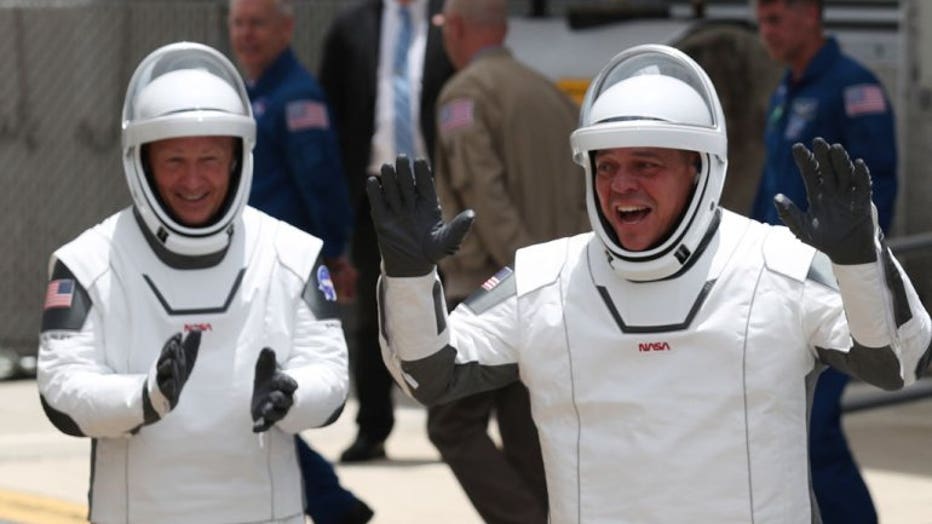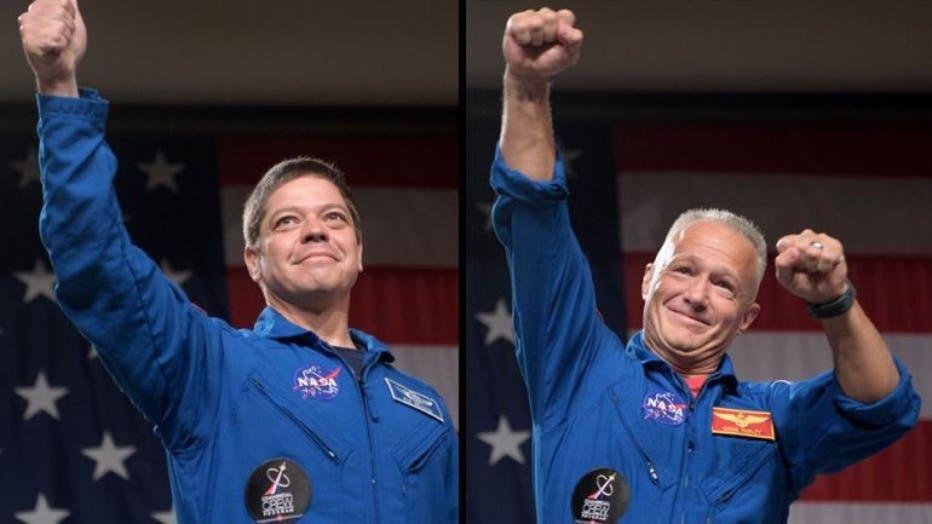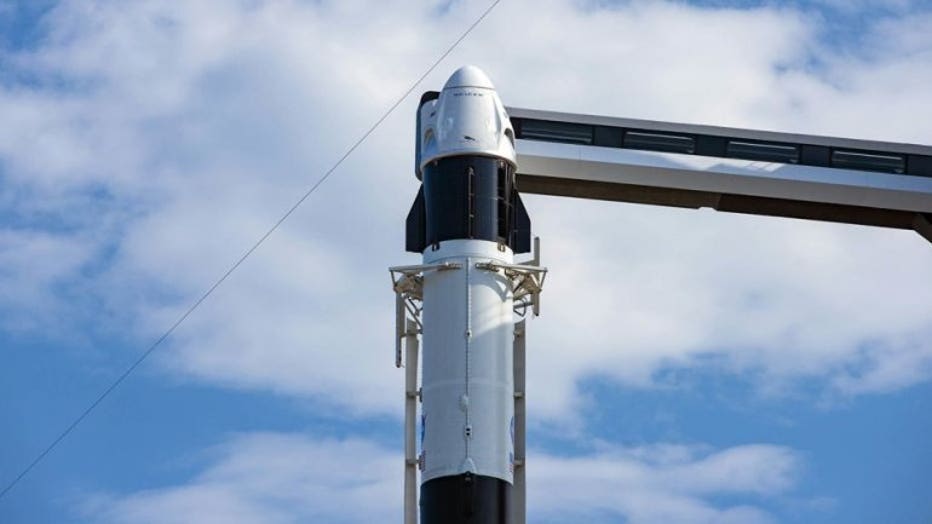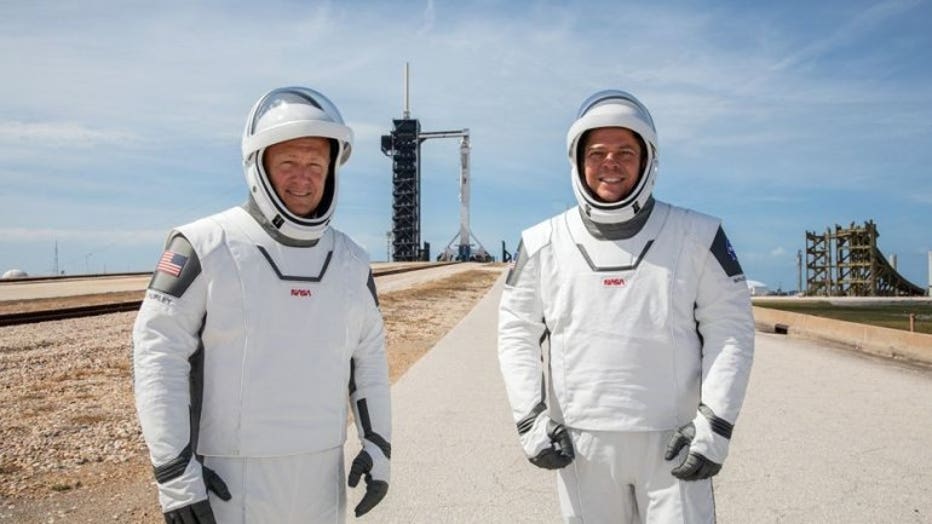Historic SpaceX launch postponed to Saturday because of stormy weather
CAPE CANAVERAL, Florida — The launch of a SpaceX rocket ship with two NASA astronauts on a history-making flight into orbit has been called off with 16 minutes to go in the countdown because of the danger of lightning.
Liftoff is rescheduled for Saturday.
Space veterans Doug Hurley and Bob Behnken were scheduled to ride into orbit aboard the brand-new Dragon capsule on top of a Falcon 9 rocket, lifting off for the International Space Station at 3:33 p.m. CDT from the same launch pad used by the Apollo moon missions a half-century ago.
Smiling, waving and giving the traditional thumbs-up as Vice President Mike Pence looked on, the two men said farewell to their families — exchanging blown kisses and pantomiming hugs for their young sons from a coronavirus-safe distance — before setting out for the launch pad in a gull-wing Tesla SUV, another product from SpaceX’s visionary founder, Elon Musk.
Thunder could be heard rumbling as the convoy of vehicles made its way toward the rocket.
The flight would mark the first time a private company sent humans into orbit. It would also be the first time in nearly a decade that the United States launched astronauts into orbit from U.S. soil.

CAPE CANAVERAL, FLORIDA - MAY 27: NASA astronauts Bob Behnken (R) and Doug Hurley (L) walk out of the Operations and Checkout Building on their way to the SpaceX Falcon 9 rocket with the Crew Dragon spacecraft on launch pad 39A at the Kennedy Space C
Ever since the space shuttle was retired in 2011, NASA has relied on Russian spaceships launched from Kazakhstan to take U.S. astronauts to and from the space station.
At midday, though, with four hours remaining before liftoff, launch controllers put the chances of acceptable weather for liftoff at just 50-50 because of rain, clouds and thunderstorms at NASA's Kennedy Space Center. A tropical storm farther up the East Coast also complicated matters.
In the event of a postponement, the next launch opportunity would be Saturday.
The preparations took place in the shadow of the coronavirus outbreak that has killed an estimated 100,000 Americans.
“We're launching American astronauts on American rockets from American soil. We haven't done this really since 2011, so this is a unique moment in time,” NASA Administrator Jim Bridenstine said.
With this launch, he said, “everybody can look up and say, ’Look, the future is so much brighter than the present.′ And I really hope that this is an inspiration to the world.”
Musk, wearing a mask and keeping his distance, chatted with the two NASA astronauts just before they left for the launch pad. The mission would put Musk and SpaceX in the same league as only three countries — Russia, the U.S. and China, which sent astronauts into orbit in that order.
NASA pushed ahead with the launch despite the viral outbreak but asked spectators to stay at home to lower the risk of spreading the virus. Beaches and parks along Florida's Space Coast are open again, and local officials and businesses put out a socially distanced welcome mat. Signs along the main beach drag wished “Godspeed SpaceX.”
Hours before the launch, cars and RVs already were lining the causeway in Cape Canaveral, with prime views of the pad.
President Donald Trump also planned to fly in for the liftoff at Kennedy, where the guest list was extremely limited because of the pandemic.
Among the sightseers was Erin Gatz, who came prepared for both rain and pandemic. Accompanied by her 14-year-old daughter and 12-year-old son, she brought face masks and a small tent to protect against the elements.
She said the children had faint memories of watching in person one of the last shuttle launches almost a decade ago when they were preschoolers.
“I wanted them to see the flip side and get to see the next era of space travel,” said Gatz, who lives in Deltona, Florida. “It’s exciting and hopeful.”
Hurley, 53, and Behnken, 49, are both two-time shuttle fliers.
NASA hired SpaceX and Boeing in 2014 to transport astronauts to the space station in a new kind of public-private partnership.. Development of SpaceX’s Dragon and Boeing’s Starliner capsules took longer than expected, however. Boeing's craft is not expected to fly astronauts into space until early 2021.
“We’re doing it differently than we’ve ever done it before," Bridenstine said. "We’re transforming how we do spaceflight in the future.”
WHO ARE THEY?
Hurley, 53, and Behnken, 49, have each flown two shuttle missions and were assigned as two of NASA’s first four commercial crew astronauts in 2015. Hurley is the mission’s commander, while Behnken will hold the new title of joint operations commander.
Both are married to fellow astronauts; Hurley’s spouse is Karen Nyberg, while Behnken is married to Megan McArthur.

Bob Behnken (left) and Doug Hurley (right). NASA photos / Bill Ingalls
BIO FACTS:
Doug Hurley:
- Born in Endicott, New York
- Selected as an astronaut in 2000
- Pilot on STS‐127 & STS‐135, the final shuttle flight
- Fighter pilot & test pilot in the USMC
- He’s traveled 11.8 million miles in space, and logged 683 hours
Bob Behnken:
- Born in in St. Ann, Missouri
- Selected as an astronaut in 2000
- Flown two missions: STS-123 & STS-130
- From 2012-2015, he served as NASA Chief Astronaut
- Logged 708 hours in space and has spent 37 hours spacewalking
WHAT ARE THEY RIDING
The Dragon spacecraft being flown on the Demo-2 mission is the upgraded version of SpaceX’s cargo-ferrying capsules, which have made 20 successful automated flights to and from the International Space Station.

A close look at the Crew Dragon capsule, ready for flight atop its Falcon 9 rocket. SpaceX photo.
Though the capsule-style spacecraft and splashdowns at sea may seem like a throwback to the space race of the 1960s, the Dragon capsules are significantly upgraded over their Cold War counterparts.
Not only are they larger, with seats for up to seven astronauts, they are reusable. Their gleaming white interiors are decked out with LED lighting and flat-screen displays, looking nothing like the dark grey industrial switch-filled panels that lined the walls of NASA’s first capsules.
The Dragon will be hoisted by SpaceX’s Falcon 9 rocket, and while the first-stage booster is also reusable, NASA requested a brand-new booster for this mission. In a nod to history, though, SpaceX was given permission to paint NASA”s red “worm” logo on the rocket, the first use of that logo since 1992.
NEW CAPSULE, NEW SUITS
NASA’s astronauts have sported many different looks through the years. From the sleek silver of the Mercury program to the proper white suits of Apollo and even the bright orange of the shuttle days, the flight suits have always made a statement – a blend of fantasy and function.
But while Hurley and Behnken will walk out of the same Kennedy Space Center doors that every other astronaut has, they’ll look a lot different. SpaceX hired Hollywood designer Jose Fernandez to help give the company’s spacesuits a unique look.
The bright white suits match the shiny white interior of the spacecraft, and they are just as sleek. They’ll provide the same level of protection for the astronauts, but add new features like 3D-printed helmets and touchscreen-friendly gloves.
The one-piece suits are custom made for each astronaut, NASA says. A single connection point on each suit’s thigh attaches life support systems, including air and power connections.

NASA photo
And the suits themselves are not the only thing getting a makeover. The astronauts will no longer be riding to the launch pad in NASA’s silver Astrovan; instead, white Teslas will ferry the astronauts to Launch Pad 39A in a not-very-subtle show of SpaceX corporate synergy.
MISSION PLAN
That roll to the launch pad will happen about three hours and 15 minutes before launch. After the astronauts get strapped into their seats and trhe access arm retracts, supercold fuel will begin to flow into the Falcon 9’s tanks – the first time that any NASA astronauts will be aboard a rocket as it is fueled.
The 4:33 p.m. liftoff window is instantaneous, meaning there is not a chance to regroup from any last-minute technical problems and try again later.
Assuming an on-time liftoff, the Dragon capsule will dock with the space station at 11:39 a.m. on Thursday. Then, Hurley and Behnken will spend anywhere from one to four months aboard the station, depending on how the capsule performs.
Following their mission, the crew will splashdown off the coast of Florida.
NEXT STEPS
If the Demo-2 flight goes well, the next SpaceX crew could fly as soon as August, NASA says. But they aren’t the only company developing space taxis; Boeing’s Starliner capsule flew an uncrewed test flight last year that experienced several issues and never made it to the space station.
Boeing plans to refly that test mission before putting astronauts aboard, perhaps later this year.
NASA, meanwhile, will be free to focus on longer-term deep-space missions. The Orion capsule, which flew an uncrewed test mission in 2014, will carry astronauts back to the moon as part of the Artemis program.
The agency is developing a large rocket using the space shuttle’s engines and upgraded boosters to launch the elements of a lunar outpost. The first launch could happen in 2021, with a moon landing in 2024.

